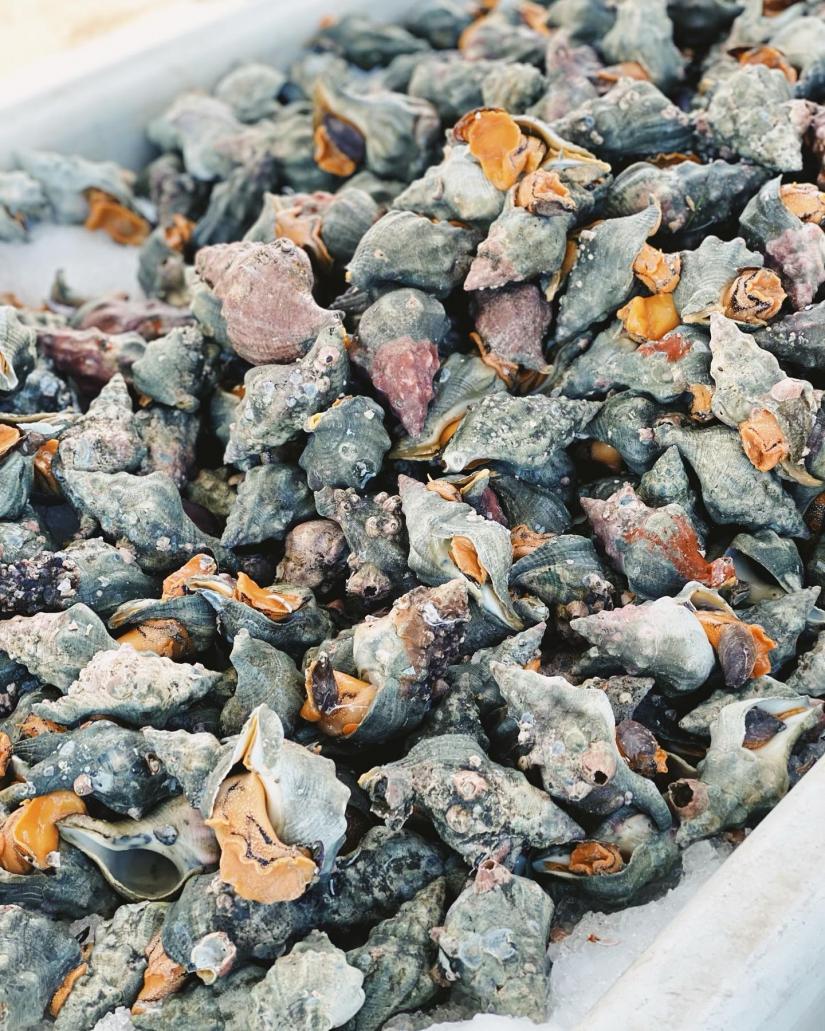Kellet's Whelk
Kelletia kelletii
The Science
THE SCIENCE
Kellet’s whelk feeds using a prehensile proboscis that extends about twice the length of the shell to reach food in crevices.
Taxonomic description
- One of the largest sea snails found in southern California. [1]
- Has a spindle shaped, spiraled shell that can reach 18 cm (7”) in length. [1]
- Shell ranges in color from white to tan with brown spiral lines, but as it ages the shell gets covered with light green or purple algae and other encrusting organisms. [1]
- The foot tissue is colored yellow with a few black stripes and white spots.
Distribution
- Found from central Baja California, Mexico to Point Conception, California. [1]
Life history
- Much is still unknown about its life cycle.
- Growth rates for this species are not well studied, but are thought to be slow at 0.75-1 cm (0.3“ to 0.4”) per year until sexual maturity; and only 9 cm (3.5”) after 20 years. [1]
- Females become sexually mature between 6.6 - 7.1 cm (2.6 - 2.8”), slightly smaller for males. [1]
- Fertilization is internal with annual spawning periods March – May. [2]
- Disc-like egg capsules are deposited on hard substrate with fertilized embryos inside that develop and emerge into the water column as free swimming larvae for an unknown amount of time. [2]
Habitat
- Commonly found in kelp forests and on rocky reef habitats, on both rocky, hard, and sandy, soft substrates. [1]
- Usually found in depths from 0 m (0 ft) down to 69 m (230 ft). It is rarely found in the intertidal zone, although it is occasionally at lowest elevations or in tide pools. [1,2]
- It is an opportunistic carnivore that feeds on dead or dying organisms on the sea floor [1] or will actively pursue prey such as turban snails. [2]
- Predators include the moon snail, sea stars, octopus, and sea otters. [1]
- Can be seen feeding alongside its predator the giant sea star.
The Fishery
THE FISHERY
Whelk landings in California likely pre-date 1979, but started to steadily increase in 1993 with the highest take in 2006 at 87 metric tons (the cargo capacity of a Boeing 747)!

Seasonal availability
- In California, open season from July 1 through the first Wednesday after March 15th unless the Total Allowable Catch of 45,360 kg (100,000 lbs) for the season is reached or projected to be reached in which case the fishery closes. [1]
Regulatory and managing authority
- As established by the Marine Life Management Act, the California Fish and Game Commission regulates this fishery, and the California Department of Fish and Wildlife manages this fishery in state waters through the CDFW’s Invertebrate Management Project. [8,9,10]
Gear type
- Caught as bycatch in lobster and crab traps: In 2008, 98% of all harvested Kellet’s whelks were taken via lobster and crab traps. [1]
- Also harvested by hand by licensed commercial fishermen (divers collect further than 305 m or 1000 ft beyond the low tide mark).
Status of the fishery
- The commercial fishery is relatively new; minimal information on the impact of recent increased commercial demands.
- Potentially vulnerable to overfishing due to slow growth rates and need for relatively high density for aggregate spawning.
- If Total Allowable Catch limits are coupled with collaborative data collections & management decisions, responsible growth of this fishery should continue.
- Not yet assessed in common sustainable seafood guides (e.g., NMFS Fish Stock Sustainability Index, Monterey Bay Aquarium Seafood Watch, NOAA Fishwatch).
Potential ecosystem impacts
- Intensive removal of this predaceous whelk may increase numbers of its prey--grazers of kelp & other seaweeds (e.g., urchins, limpets, and snails) [3], which can lead to seaweed overgrowth in rocky reefs & kelp forests. [4]
- Collection methods are low impact, as hand (diver) collection have virtually no impact, but traps can cause damage to the seafloor in rough conditions.
The Seafood
THE SEAFOOD
Prehistoric snack? Kellet’s whelk shells have been found in archeological and paleontological sites in Southern California.


Edible portions
- Typically only the muscular foot, which is similar to abalone, is eaten.
Description of meat
- The meat is firm and chewy if untenderized, firm and tender once tenderized.
- This whelk is known to be juicy and salty. [6]
Culinary uses
- The meat is usually removed from shell for use. [7]
- To tenderize, meat may be frozen for 5 min, pounded, or pressure cooked.
- Only minimal cooking is required, about 10-15 min in boiling salt water.
- It can be served from the shell after lightly boiling.
- This whelk is used in soups, chowders, fish pies, pasta dishes & seafood salads.
- For a recipe for Italian scungilli with linguine, visit Antonio's. [11]
- For a recipe for whelk salad with shiso leaves and spring onion, visit Umami Diary. [12]
Nutritional information
- Whelk, cooked, moist heat (3 oz). [5]
Toxicity report
- No known toxins.
Seasonal availability
- Available fresh from July – March. [1]
References
[1] Hubbard, K. 2008. Kellet’s whelk, Kelletia kelletii. Status of the Fisheries Report 2008. California Department of Fish and Wildlife. 28 July 2013. < https://nrm.dfg.ca.gov/FileHandler.ashx?DocumentID=34437&inline=true>.&…;
[2] SIMoN. Sanctuary Integrated Monitoring Network – Kellet’s Whelk – Available: https://sanctuarysimon.org/dbtools/species-database/
[3] Halpern et al. 2006. Strong Top-Down Control in Southern California Kelp Forest Ecosystems. Science312: 1230-1232. https://doi.org/10.1126/science.1128613
[4] Denny, M. W., S.D. Gaines. 2007. Encyclopedia of tidepools and rocky shores. Berkeley: University of California Press.
[5] SELF Nutrition Data. 2013. "Mollusks, whelk, unspecified, cooked, moist heat. https://nutritiondata.self.com/facts/finfish-and-shellfish-products/4200/2
[6] BBC. 2013. Whelk Recipes. BBC - Food Ingredients. www.bbc.co.uk/food/whelk
[7] “Cleaning a whelk.” YouTube. Posted 20 Feb 2009 by sellsfish. Web. 28 July 2013. < http://www.youtube.com/watch?v=L8teuNuqRsg>.
[8] Marine Life Management Act. n.d. California Department of Fish and Wildlife. Web. https://wildlife.ca.gov/Conservation/Marine/MLMA. Accessed 24 August 2020.
[9] California Department of Fish and Wildlife. 2019. Kellet's Whelk, Kelletia kelletii, Enhanced Status Report. Web. https://marinespecies.wildlife.ca.gov/kellet%E2%80%99s-whelk/. Accessed 1 December 2020.
[10] Invertebrate Management Project. N.d. California Department of Fish and Wildlife. Web. https://wildlife.ca.gov/Conservation/Marine/Invertebrates. Accessed 24 August 2020.
[11] Antonio's. 2004. Scungilli with Linguine. Web. https://antoniosonline.com/scungilli-with-linguine/. Accessed 13 January 2021.
[12] Umami Diary. 2016. Aya's Kitchen: Whelk Salad with Shiso and Spring Onion. Web. https://umamidiary.com/2016/04/28/ayas-kitchen-whelk-salad-with-shiso-a…. Accessed 13 January 2021.
[13] Lonhart, S. SIMoN. 2005. Digital image. Web. https://sanctuarysimon.org/dbtools/photo-library/id/1103. Accessed 17 February 2021.
[14] kstolzenbach. flickr. 2012. Kellet's whelk laying eggs. Digital image. Web. https://flickr.com/photos/42857504@N05/7162246723. Accessed 17 February 2021.
[15] Tuna Harbor Dockside Market. Facebook. 2021. Digital image. Web. https://www.facebook.com/thdocksidemarket/photos/4123589121003673. Accessed 17 February 2021.
[16] Young Sok Yun 윤영석. flickr. 2013. Whelk with stonecrops. Digital image. Web. https://flickr.com/photos/pabo76/8586516911. Accessed 17 February 2021.



